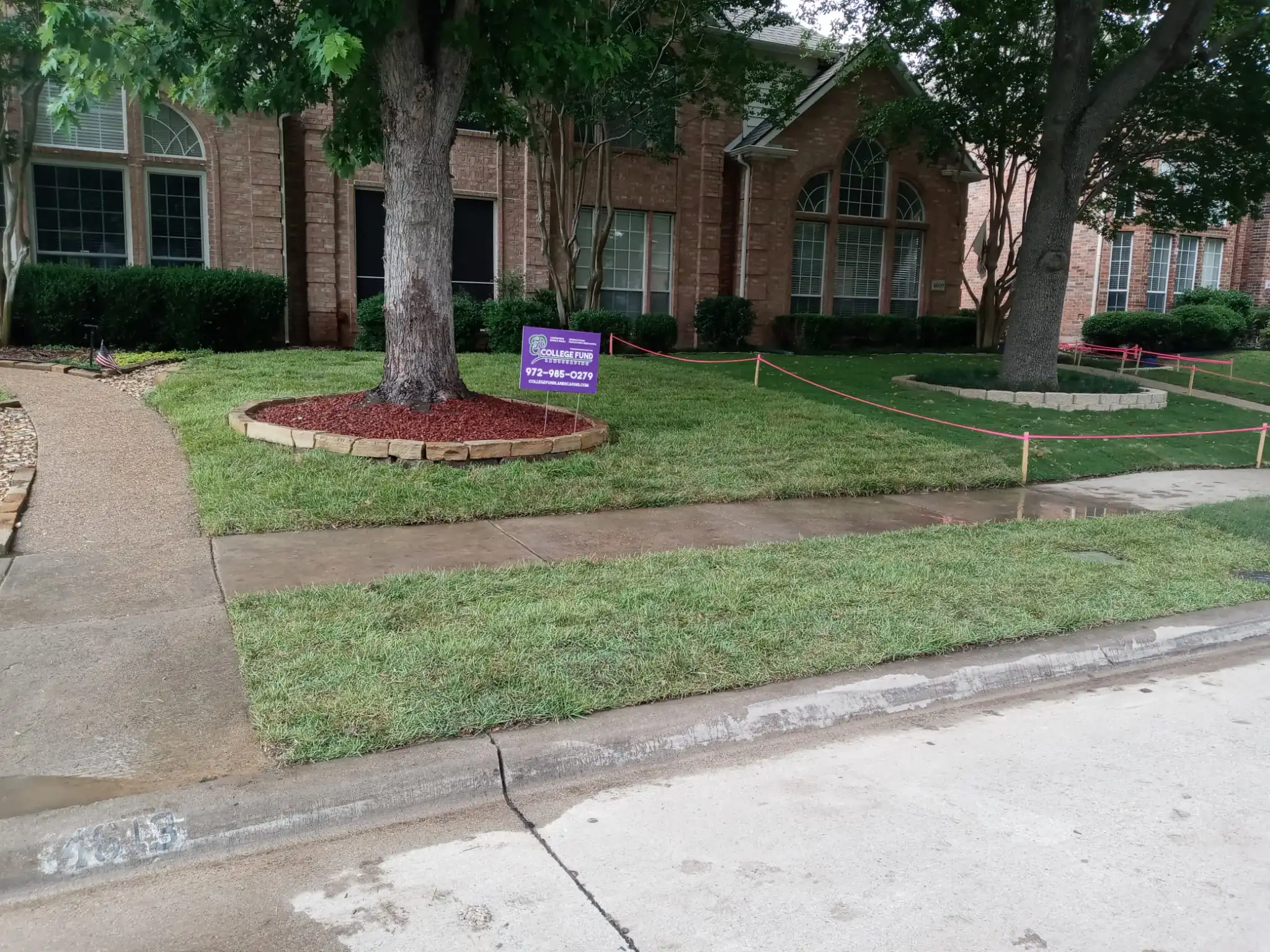Proper lawn watering is crucial for maintaining a healthy and vibrant lawn in Collin County, TX, during the scorching summer months. Understanding the best time to water and following essential watering tips can make all the difference between healthy and stressed lawns.
It’s essential to strike the right balance regarding watering frequency, ensuring your lawn receives adequate hydration without overwatering. Additionally, proper watering will help your turfgrass grow deep roots and stay healthy, no matter what summer weather is like.
The Importance of Proper Lawn Watering in Collin County, TX
Assuming you have installed a lawn sprinkler system on your property, you should know how to operate it and set it to meet your Frisco lawn’s watering needs. Remember to water early by setting your irrigation system’s timer to turn on between 4 a.m. and 6 a.m.
There’s less wind and better water absorption in the early morning hours. The water doesn’t sit on the turfgrass blades to develop lawn diseases, and the water can penetrate the soil before the sun causes evaporation.
Learn more: Benefits of Full-Service Lawn Care in North Texas
If you water your lawn in the early evening, ensure the sprinkler system shuts off before late evening. You don’t want water on top of your turfgrass’s leaves overnight, where fungal diseases can form.
Also, infrequent and deep watering benefits your lawn; not a shallow sprinkle of your lawn hose every evening. Deep watering causes turfgrass roots to grow deep in the soil to find moisture stores during the hot, dry summer months.
Understanding Your Lawn’s Watering Needs
Different types of grass may be growing in your Frisco lawn. Since you have warm season grass, it may be Bermuda, Zoysia, or St. Augustine.
You may also have fescue grass, a cool season turfgrass growing in shaded areas. All four types of grass have different watering needs.
Fescue turfgrass, for example, needs 1.5 inches of water per week. So, you need to adjust that irrigation zone to allow more water for fescue compared to Zoysia, St. Augustine, or Bermuda.
Alternatively, St. Augustine turfgrass needs 1 inch of water per week, based on a fact sheet by Texas A&M AgriLife Extension.
According to Texas Water Development Board, your lawn only needs an inch of rain weekly. If you get rain during the week, subtract how much you received from 1 inch (adjust the total amount based on your turfgrass needs), and set your lawn sprinkler system to provide the rest.
How do you know if your in-ground sprinkler system delivers 1 inch of water to your lawn in a week?
One inch of rain wets the soil from 4 to 6 inches to hit your turfgrass’s root system. You can measure that depth using a soil probe or a screwdriver to see if the water percolates to 4-6 inches.
Remember that the type of soil you have—sandy, loam, or clay also affects how water is absorbed and stays in the ground. Water soaks through sandy soil quickly, so you’ll need to water more often.
Clay soil, on the other hand, holds moisture longer, but it takes more water to reach a depth of 4 to 6 inches. You’ll water less often during the week but more deeply.
Loam soil is the soil that you want to have with your turfgrass. Loam soil is similar to the type of dirt that you find in the woods—dark, rich hummus that smells like a forest.
Read more: The Scoop on Sprinklers: Common Problems with Irrigation Systems and How to Fix Them
Using Cycle & Soak to Effectively Irrigate Your North Dallas Lawn
Here’s how to ensure that your turf gets enough water, according to FriscoTexas.gov: Use cycle and soak watering, where you run your lawn sprinkler system in 15-20 minute cycles so that the water will absorb into the ground.
You don’t want the water to run off your lawn. Instead, you want it to soak deeply into the soil.
However, running your lawn sprinkler for 30 minutes or more wastes water. For example, the website says running your sprinkler system for 30 minutes per zone uses the same amount of water as a 4-hour shower.
Remember that you’ll need to adjust your sprinkler system in the fall when there’s more rain, and the temperatures start to cool. In springtime, you’ll need to switch your sprinkler system again to ensure there’s enough water being delivered for summertime use.
How Your Lawn Sprinkler System Helps the Soil Absorb Fertilizer and Pre-Emergent Weed Control
When our technicians at College Fund Landscaping visit your property to apply lawn fertilizer and weed control, we leave you with instructions after each application. We recommend turning on your lawn sprinkler system for 15 to 30 minutes.
This short watering session will help the nutrients get absorbed into the soil. However, you don’t want to overwater your lawn after a fertilizer treatment because the nutrients will leach out of the ground.
Additionally, the pre-emergent weed control we put on your lawn will need to be activated by watering your lawn. Again, 15–30 minutes of watering activates the pre-emergent, creating that barrier to keep poa annua and other grassy weeds out of your Sachse lawn.
Practice Preventative Lawn Maintenance
You must practice preventative lawn maintenance this summer for a healthy, robust lawn. Proper lawn maintenance includes
- Only mow your lawn with sharp blades
- Only take the top third off the turfgrass during the hot summer months
- Only mow during the late morning when the dew has dried or early evening
- Make sure you have regular lawn fertilization and weed control treatments
- Only water your lawn infrequently and deeply at 1 to 1.5 inches per week
- Make sure you aerate your lawn in the spring
- Dethatch your lawn on years when you don’t aerate your lawn
- Keep leaves and other debris off of your turfgrass
- Get a soil test every two to three years.
How College Fund Landscaping Keeps Your Collin County, TX Lawn Looking Its Best
While you provide the water, we’ll give the lawn care services that your turfgrass needs to look healthy and vibrant all summer. At College Fund Landscaping, we offer the following lawn and landscaping services for North Dallas, TX, homeowners:
- Lawn mowing
- Lawn fertilization and weed control
- Shrub and bed services
- Sod installation
- Design and install
- Mulch installation
- Stonework
- Drainage
- Irrigation
- Hardscapes.
By following this guide, you’ll be equipped with the knowledge to keep your North Dallas lawn looking lush and green throughout the summer. Your irrigation goals for your TX lawn should be to water deeply and infrequently. If you’re ready to start a lawn fertilization program, call us today at 972-985-0279 or fill out our contact form.
Sources:
AggieTurf.TAMU.edu, St. Augustinegrass Lawn Management (pdf).
FriscoTexas.gov, Cycle & Soak Watering.
TWDB.Texas.gov, A Water Guide for Texas Landscapes (pdf).



Comments (0)
Thanks for your comment!
Thanks for your feedback! Your comments have been successfully submitted! Please note, all comments require admin approval prior to display.
Error submitting comment!
There is a problem with your comment, please see below and try again.